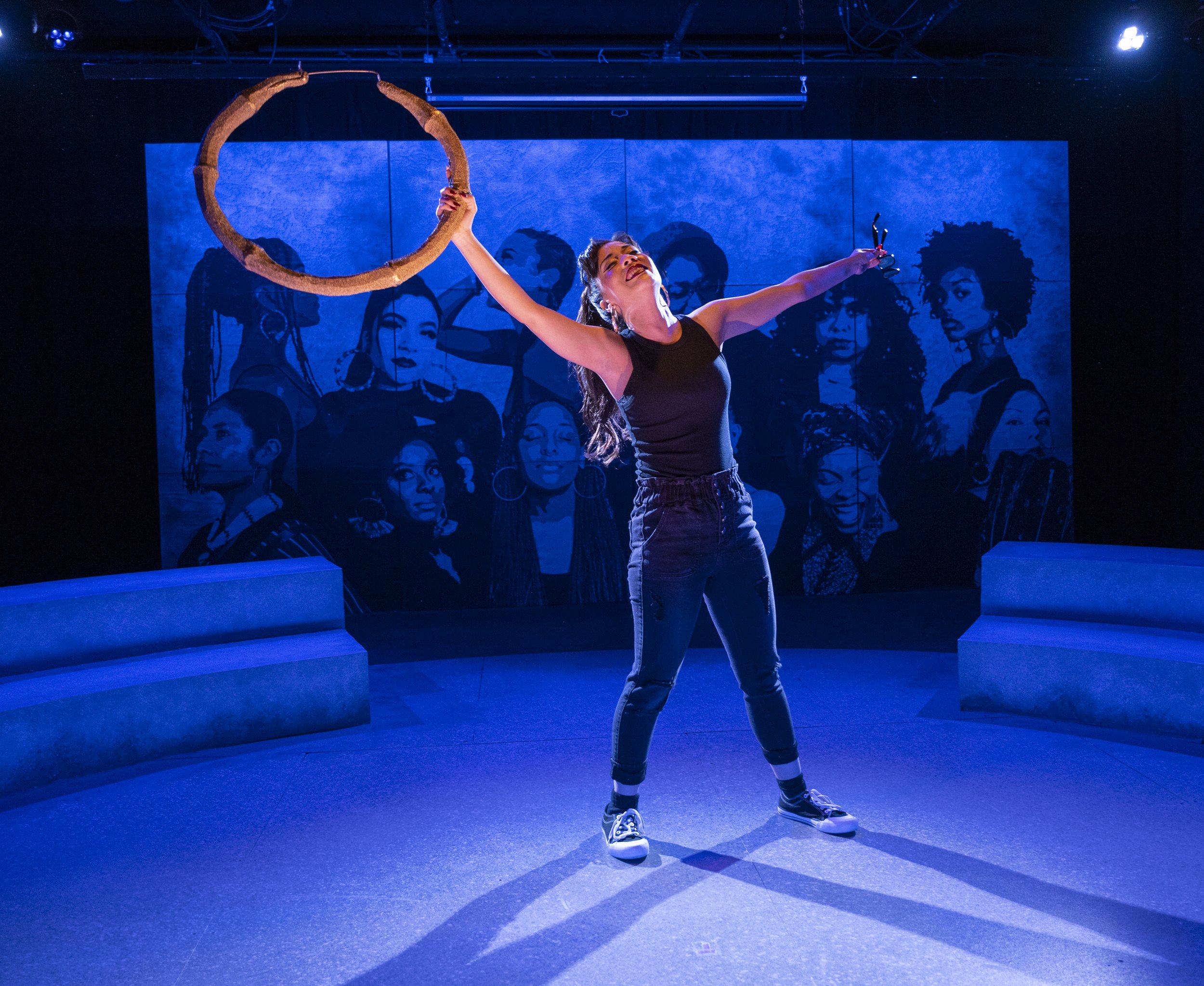Art Inspires Art with MCT’s New Play Hoops
Photo by Michael Brosilow.
When Alexandria Ocasio-Cortez took office in 2019, she wore bright red lipstick and large, gold hoop earrings to her swearing-in ceremony. In a tweet later that day, AOC commented on her appearance at the solemn occasion. “Lip and hoops were inspired by [Supreme Court Justice] Sonia Sotomayor, who was advised to wear neutral-colored nail polish to her confirmation hearings to avoid scrutiny. She kept her red. Next time someone tells Bronx girls to take off their hoops, they can just say they’re dressing like a congresswoman.”
Like AOC, many Black, Latinx, Asian, and Indigenous women regard hoop earrings as much more than an accessory. They can be a statement of confidence, a link to family, a connection to history, or a signifier for beauty and femininity. Hoop earrings can also be a basic part of one’s cultural identity, an act of defiance, or a non-verbal warning to others.
The connection that many women of color feel to these earrings is explored in the new play Hoops by Eliana Pipes, with music by B∼Free. Commissioned by Milwaukee Chamber Theatre, the piece was inspired by a photography exhibit by the same name, created by MCT marketing director Nicole Acosta. Featuring stunning portraits of women wearing the titular jewelry, “Hoops” visually explored women’s relationships with hoop earrings, while captioning the photos with mini interviews from each subject. Building on the exhibit and expanding the scope of the conversation, Hoops is part of the state-wide initiative World Premiere Wisconsin, which celebrates new work. Directed by Patrice Amon, the 80-minute production runs through April 2 in the Studio Theatre in Milwaukee’s Broadway Theatre Center.
Photo by Michael Brosilow.
Like a photo exhibit, Hoops is made up of individual scenes that each tell a slightly different story around the central theme. The length, tone, and style of these scenes cover a whole gamut – from direct address realism to the musical and absurd – adding new perspectives to the conversation every few minutes and introducing the audience to passionate, diverse, sometimes even contradictory layers of meaning.
This collage of moments is brought to life by three talented actresses – Paulina Lule, Ashley Oviedo, and Celia Mandela Rivera – who command the stage, making a series of bold, straightforward statements about their hoops. Whether the earrings are large or small; platinum, gold, gold-plated, or made of other colorful materials; cheap or expensive; family heirlooms or a new impulse purchase; the three women talk to us and each other about how the earrings make them feel, the reasons they wear them, and the way they are each perceived by others when adorned with their hoops.
Photo by Michael Brosilow.
The scenes range from poignant to silly, examining where hoop earrings originated (in ancient Mesopotamia around 2,500 BCE), how they entered American pop culture, and the plethora or statements they make, depending on context. Some beats feel like aggregates of common experiences, while others are based on unique personal interviews. In between these scenes, the actresses sing, dance, and laugh together, bringing us along with them on the journey to the next story.
Like the original art exhibit, Hoops has a wide variety of narratives gathered around a thematic throughline, and some pieces are naturally more impactful than others. Ashley Oviedo excels in musical and comic moments, singing a wistful ballad while personifying an enormous hoop earring that has been separated from its mate. She is also fantastic while demonstrating a brand new hoop earring that can capture negative statements lobbed at the wearer, before they enter the ear and brain. Paulina Lule soars in two very different character monologues – one about a woman who is comforted by her grandmother’s hoop earrings while facing a cancer diagnosis, and one as an LGBTQ+ youth who considers how hoop earrings mesh with their masculinity. Celia Mandela Rivera adeptly explores how hoops are labeled as inappropriate in white-centric workplaces, and how the pressure to fit into a corporate world asks women of color to hide their cultural identities.
All of these stories of hoop earrings are placed in front of a minimal set that contains two large, gold curved benches meant to evoke the title, while the backdrop features a painting of diverse women that echoes many of the original “Hoops” photos. (Utilitarian set design by Madelyn Yee.) The women each wear a black base costume with additional pieces layered to indicate specific characters throughout the show. Sweaters, jackets, purses and other accessories are accented with additional hoop earrings, used for extra emphasis. (Flexible costume design by Kyndal Johnson.)
The theatrical version of Hoops fulfills both Acosta’s original objectives and MCT’s: making space for Black and brown women to tell their stories, and being more inclusive in representing the experiences of the larger community.


